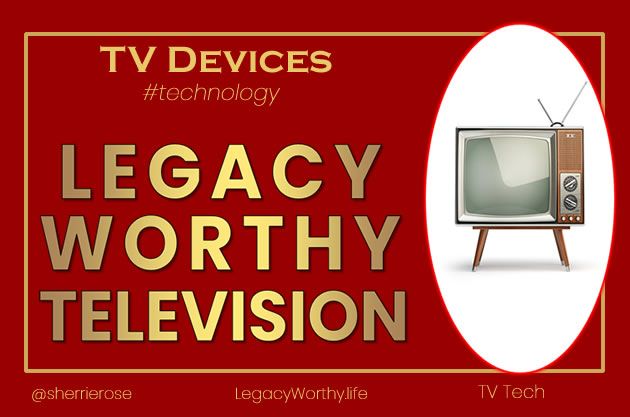Legacy Worthy Television: Television Technology

Television Technology
Television technology has come a long way since its inception, and there have been several advancements in the medium over the years. Here is a brief overview of the progression of television from cathode ray tubes and antennas to today’s TV devices and streaming media:
Cathode Ray Tubes (CRT): The first television sets used cathode ray tubes (CRTs) to display images. These bulky devices used a vacuum tube to produce an electron beam that would scan across a phosphorescent screen, creating an image.
Analog TV: In the mid-20th century, analog television became the norm. These sets used radio waves to receive signals from broadcast towers, and the signals were converted into video and audio. Analog television sets required antennas to pick up signals, and the picture quality was relatively low.
Digital TV: In the 21st century, digital television replaced analog TV. Digital sets use signals that are transmitted as binary code, and they require less bandwidth than analog signals. Digital television sets can produce higher quality images and sound than their analog counterparts.
Flat-screen TVs: In the late 1990s, flat-screen TVs were introduced, which used liquid crystal display (LCD) technology to produce images. Later, LED and OLED screens were developed, which produced better image quality and were more energy-efficient. This television technology has longevity.
Smart TVs: In the 2010s, smart TVs were introduced, which were Internet-enabled and allowed viewers to access streaming services like Netflix, Hulu, and Amazon Prime Video. Smart TVs also allowed users to connect to other devices like smartphones and laptops.
Streaming Media Devices: Streaming media devices, such as Roku, Apple TV, and Chromecast, were developed to allow users to stream content from the Internet to their televisions. These devices are typically small and plug into the HDMI port on a TV.
Streaming Services: Streaming services have become increasingly popular, offering users access to on-demand content and live TV channels. Services like Netflix, Hulu, and Amazon Prime Video offer a wide range of content, including original programming.
The progression of television technology has been characterized by advancements in image quality, energy efficiency, and the ability to access content from a variety of sources. Today’s viewers have more options than ever before when it comes to watching television, and the medium is likely to continue evolving in the coming years.
Analog Recording Technologies
VHS (Video Home System) and Betamax
Television technology before the advent of digital recording devices like DVRs, viewers used analog recording technologies to record and watch television shows and movies. Two of the most popular analog recording technologies were VHS (Video Home System) and Betamax. Here’s a brief overview of these technologies:
Betamax: Betamax was introduced by Sony in the mid-1970s and was the first commercially available video cassette recording format. Betamax tapes were smaller than VHS tapes, and the image quality was generally considered to be higher. However, Betamax was more expensive than VHS and had a shorter recording time.
VHS: VHS was introduced by JVC in the late 1970s and quickly became the dominant video cassette format. VHS tapes were larger than Betamax tapes, but they had a longer recording time and were less expensive. VHS also had a wider range of available recording times, from 30 minutes to 8 hours, compared to Betamax’s maximum recording time of 5 hours.
Other Analog Recording Technologies: Other analog recording technologies were developed around the same time as VHS and Betamax, including Video 2000 and VHS-C. Video 2000 was developed by Philips and was only available in Europe, while VHS-C was a smaller version of VHS used primarily for camcorders.
Decline of Analog Recording: Analog recording technologies like VHS and Betamax began to decline in popularity in the 1990s with the introduction of digital recording technologies like DVD and DVRs. By the early 2000s, VHS was largely replaced by DVD, and Betamax had been discontinued.
While analog recording technologies like VHS and Betamax may seem outdated by today’s standards, they played a significant role in the evolution of television technology, providing viewers with the ability to record and watch shows at a later time. The development of digital recording technologies like DVRs and cloud DVRs has largely replaced the need for analog recording, but the impact of VHS and Betamax on the history of television remains significant. This television technology was the beginning of time-shifting.
DVR (Digital Video Recorder) devices
Television technology made major progress with the advent of DVR (Digital Video Recorder) devices are another significant development in the evolution of television technology. These devices allow viewers to record television shows and movies and watch them at a later time, providing greater flexibility and convenience for viewers. Here’s a brief overview of DVR technology:
Early DVRs: The first DVRs were introduced in the late 1990s and early 2000s. They used hard disk drives to store recorded content, and users could record shows by manually setting recording times or programming the device to record shows automatically.
Cable and Satellite DVRs: Cable and satellite TV providers began offering DVRs to their customers in the early 2000s. These DVRs were integrated with cable or satellite TV service and allowed viewers to record shows directly from their cable or satellite TV lineup.
Standalone DVRs: Standalone DVRs became popular in the mid-2000s. These devices were not tied to any particular cable or satellite TV provider and allowed viewers to record shows from over-the-air broadcast TV or from cable and satellite providers.
Networked DVRs: In the late 2000s and early 2010s, networked DVRs were introduced. These devices allowed users to access their recorded content from other devices, such as smartphones, tablets, and laptops.
Cloud DVRs: In recent years, cloud DVRs have become increasingly popular. These services allow viewers to record shows and movies to a cloud-based server, rather than a physical hard drive. Users can access their recorded content from any device with an internet connection.
DVR technology has had a significant impact on the way we watch television, providing viewers with greater flexibility and control over their viewing experience. While the television technology has evolved significantly over the years, the core concept of being able to record and watch shows at a later time remains a valuable feature for many viewers.
Key Developments in Television Technology
Television technology has seen many other developments and advancements in television technology that could be added to this discussion. Here are a few examples:
High-Definition Television (HDTV): In the late 1990s and early 2000s, HDTV was introduced as a new standard for television broadcasting. HDTV provides a much higher resolution than standard-definition television, resulting in a clearer and more detailed picture.
3D Television: In the early 2010s, 3D television became available for home viewing. This technology used special glasses to create the illusion of depth on the TV screen, providing a more immersive viewing experience.
Smart TVs: Smart TVs were introduced in the mid-2010s and allow viewers to access streaming services, browse the internet, and use apps directly on their TV.
Virtual Reality (VR) Television: Virtual reality television is an emerging technology that allows viewers to watch television shows and movies in a fully immersive virtual reality environment.
Streaming Services: In recent years, streaming services like Netflix, Hulu, Paramount+, Peacock, and Amazon Prime Video have become increasingly popular. These services allow viewers to watch TV shows and movies on-demand, without the need for a traditional TV broadcast or recording device.
8K Television: 8K television is the latest high-resolution format for television displays, offering four times the resolution of 4K and 16 times the resolution of standard high-definition.
The advancements in television technology have drastically changed the way we consume and interact with television content. From higher-resolution displays to streaming services and virtual reality, the future of television is sure to continue evolving in exciting new ways.
Apps for Television Technology
There are many apps available that can help a person watch television content. Here are some examples:
Netflix: Netflix is a subscription-based streaming service that allows users to watch TV shows and movies on-demand.
Hulu: Hulu is another subscription-based streaming service that offers a wide range of TV shows and movies, including current and past seasons of many popular shows.
Amazon Prime Video: Amazon Prime Video is a subscription-based streaming service that offers TV shows, movies, and original content.
Sling TV: Sling TV is a live TV streaming service that allows users to watch live TV channels on their mobile devices or smart TVs.
YouTube TV: YouTube TV is another live TV streaming service that offers a wide range of channels, including local networks.
HBO Max: HBO Max is a subscription-based streaming service that offers HBO’s library of shows and movies, as well as a wide range of additional content.
Disney+: Disney+ is a subscription-based streaming service that offers a wide range of Disney-owned content, including movies, TV shows, and original content.
Plex: Plex is a media server software that allows users to stream their own media files, including TV shows and movies, to their mobile devices or smart TVs.
Peacock TV: Peacock TV is a streaming service offered by NBCUniversal that offers a mix of on-demand TV shows and movies, as well as live sports and neews.
Paramount+: Paramount+ is a subscription-based streaming service that offers a wide range of TV shows and movies from the Paramount Pictures library, as well as original content and live sports.
Television technology can be accessed with the apps available to allow users to watch television content, depending on their interests and preferences. Whether you’re looking for live TV, on-demand content, or your own media library, there is likely an app that can meet your needs. Both Peacock TV and Paramount+ are popular options for those looking to expand their streaming options beyond the traditional services like Netflix and Hulu. With a wide range of content and subscription options, these services can be a great way to watch your favorite TV shows and movies.
Television technology has come a long way since its inception, from the early days of cathode ray tubes and antennas to today’s smart TVs and streaming services. Analog recording technologies like VHS and Betamax allowed viewers to record and watch shows at a later time, while digital recording devices like DVRs and cloud DVRs have largely replaced the need for analog recording. High-definition television, 3D television, and virtual reality television have all provided viewers with more immersive and engaging experiences. Smart TVs and streaming services like Netflix have changed the way we consume television content, and the latest advancements in television technology, like 8K displays, promise even more exciting possibilities for the future.

See also:



